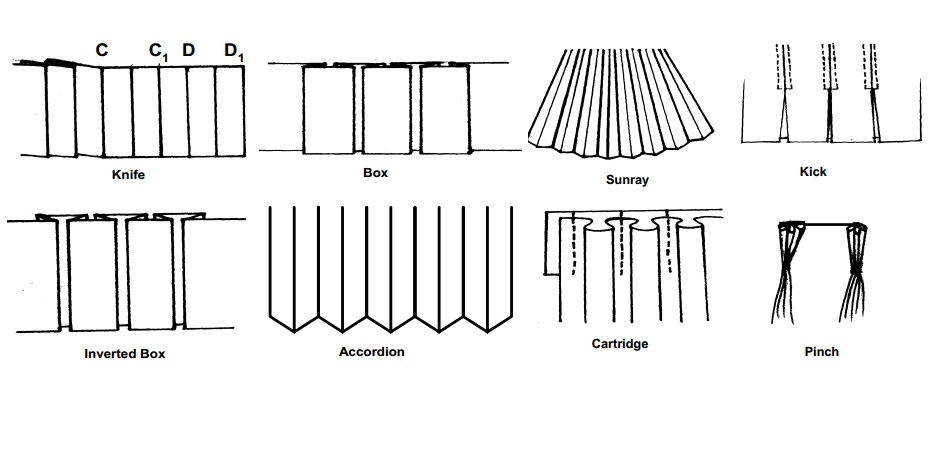Chapter: 11th 12th std standard Textiles And Dress Designing Cloth stitch Higher secondary school College practical steps methods Notes
Textiles Design and Production - Pleats

PLEATS:
Pleats are introduced usually at the waistline of skirts and dresses to provide fullness evenly all around. The preparation of pleats is similar to that of tucks, the main difference being that pleats are wider than tucks. Knife pleats, box pleats or inverted pleats are used in dresses.
1. Knife Pleat:
These are used in the place of gathers. They are usually about �' - 2' wide and are turned towards the same direction. The figure shows two knife pleats tacking in position and marking for two more pleats. To form the third pleat, make a fold along line C and bring this fold to the right so as to lie over line C1. Similarly the fourth pleat will bring D over D1. The distance CC1 is twice the width of the finished pleat.
2. Box Pleats:
Two knife pleats turned away from each other (one to the left and one to the right) form a box pleat. This can be used in frocks and skirt waistline.
3. Inverted pleat:
It is the opposite of box pleat. It is made up of two knife pleats turned towards each other so that the folds meet in the middle on the right side of the garment. This is used mostly in uniforms and skirt.
4. Accordion pleat:
It is a very narrow, straight pleats, equal in width to each other. The folds resembles the bellows of an accordion, from which the name is derived. The width ranges from 3 to 13 mm. These are close together and depth is equal from waist to hem.
5. Sunray pleat:
Pleats which fan out and graduate from the waist. These pleats are set in the industries and to sustain pleating, the fabric used should be a synthetic or a blend with over 50% synthetic fibers. These are usually used on a circular skirts.
6. Kick pleat:
Any type of pleat such as knife pleat, box pleat, or inverted box pleat can be used to decorate this type of skirt. After pleating, a top, stitch near to the fold if made till the desired length (should not be made till the hem edge) and decorated.
7. Cartridge pleat:
These are round pleats used for door and window curtains. Firm heavy fabrics will be more suitable for this type of pleats. Take a strip of material, � the time as long as the section of the curtain material, which is to be trimmed with pleats. (eg. Strip length - 20'; curtain length - 40').
Make markings of 2' distance in curtain fabric and make marking on strips of 1' distance in between each marking. Tuck and stitch the curtain to the strip, matching the
marking lines exactly. Do not press.
8. Pinch pleat: `
There are also used on curtains and draperies. These pleats are stitched part way down and so the markings are made as for tucks. Make three equal small pleats and baste them together along the top and front edge, press and machine the three pleats together across the bottom ends.
Related Topics